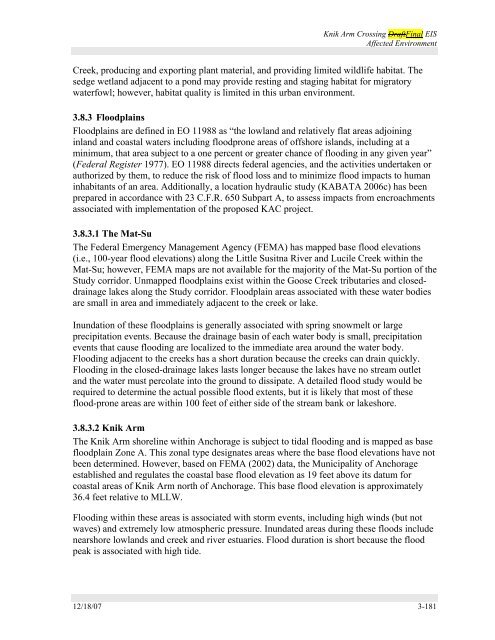3.0 Affected Environment - Knik Arm Bridge and Toll Authority
3.0 Affected Environment - Knik Arm Bridge and Toll Authority
3.0 Affected Environment - Knik Arm Bridge and Toll Authority
You also want an ePaper? Increase the reach of your titles
YUMPU automatically turns print PDFs into web optimized ePapers that Google loves.
<strong>Knik</strong> <strong>Arm</strong> Crossing DraftFinal EIS<br />
<strong>Affected</strong> <strong>Environment</strong><br />
Creek, producing <strong>and</strong> exporting plant material, <strong>and</strong> providing limited wildlife habitat. The<br />
sedge wetl<strong>and</strong> adjacent to a pond may provide resting <strong>and</strong> staging habitat for migratory<br />
waterfowl; however, habitat quality is limited in this urban environment.<br />
3.8.3 Floodplains<br />
Floodplains are defined in EO 11988 as “the lowl<strong>and</strong> <strong>and</strong> relatively flat areas adjoining<br />
inl<strong>and</strong> <strong>and</strong> coastal waters including floodprone areas of offshore isl<strong>and</strong>s, including at a<br />
minimum, that area subject to a one percent or greater chance of flooding in any given year”<br />
(Federal Register 1977). EO 11988 directs federal agencies, <strong>and</strong> the activities undertaken or<br />
authorized by them, to reduce the risk of flood loss <strong>and</strong> to minimize flood impacts to human<br />
inhabitants of an area. Additionally, a location hydraulic study (KABATA 2006c) has been<br />
prepared in accordance with 23 C.F.R. 650 Subpart A, to assess impacts from encroachments<br />
associated with implementation of the proposed KAC project.<br />
3.8.3.1 The Mat-Su<br />
The Federal Emergency Management Agency (FEMA) has mapped base flood elevations<br />
(i.e., 100-year flood elevations) along the Little Susitna River <strong>and</strong> Lucile Creek within the<br />
Mat-Su; however, FEMA maps are not available for the majority of the Mat-Su portion of the<br />
Study corridor. Unmapped floodplains exist within the Goose Creek tributaries <strong>and</strong> closeddrainage<br />
lakes along the Study corridor. Floodplain areas associated with these water bodies<br />
are small in area <strong>and</strong> immediately adjacent to the creek or lake.<br />
Inundation of these floodplains is generally associated with spring snowmelt or large<br />
precipitation events. Because the drainage basin of each water body is small, precipitation<br />
events that cause flooding are localized to the immediate area around the water body.<br />
Flooding adjacent to the creeks has a short duration because the creeks can drain quickly.<br />
Flooding in the closed-drainage lakes lasts longer because the lakes have no stream outlet<br />
<strong>and</strong> the water must percolate into the ground to dissipate. A detailed flood study would be<br />
required to determine the actual possible flood extents, but it is likely that most of these<br />
flood-prone areas are within 100 feet of either side of the stream bank or lakeshore.<br />
3.8.3.2 <strong>Knik</strong> <strong>Arm</strong><br />
The <strong>Knik</strong> <strong>Arm</strong> shoreline within Anchorage is subject to tidal flooding <strong>and</strong> is mapped as base<br />
floodplain Zone A. This zonal type designates areas where the base flood elevations have not<br />
been determined. However, based on FEMA (2002) data, the Municipality of Anchorage<br />
established <strong>and</strong> regulates the coastal base flood elevation as 19 feet above its datum for<br />
coastal areas of <strong>Knik</strong> <strong>Arm</strong> north of Anchorage. This base flood elevation is approximately<br />
36.4 feet relative to MLLW.<br />
Flooding within these areas is associated with storm events, including high winds (but not<br />
waves) <strong>and</strong> extremely low atmospheric pressure. Inundated areas during these floods include<br />
nearshore lowl<strong>and</strong>s <strong>and</strong> creek <strong>and</strong> river estuaries. Flood duration is short because the flood<br />
peak is associated with high tide.<br />
12/18/07 3-181
















